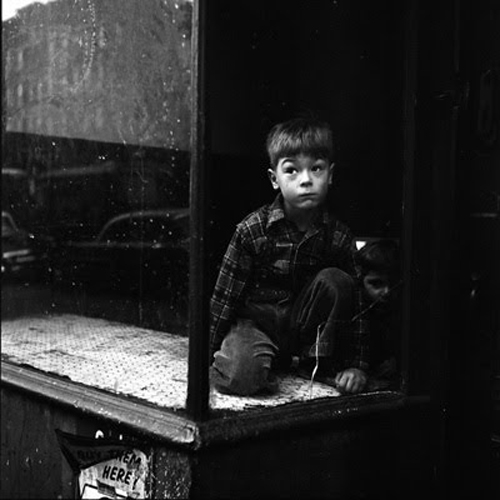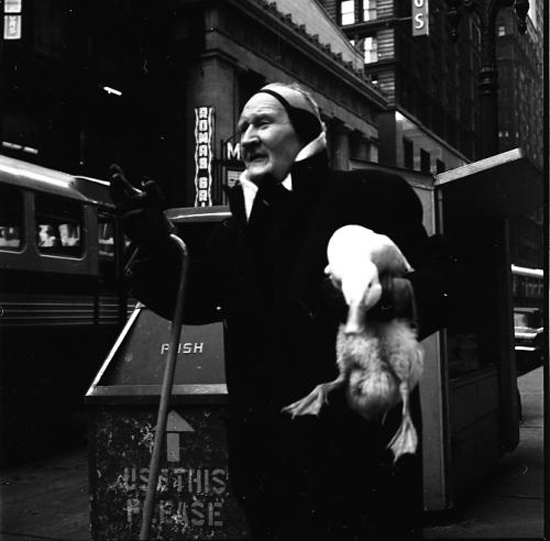Everybody loves a mystery — and right there, that’s the beginning of the problem. Who is Vivian Maier? And everybody loves a success story — and there you have the middle of the problem. Vivian Maier is now famous, and the people who ‘discovered’ her have become important. And finally, everybody loves to see the high brought low — the tag end of the problem. Vivian Maier was just an amateur and the people who’ve made her famous are vultures picking off her bones.
I suspect everybody who pays attention to photography knows the basic outline of the Vivian Maier story. Photographer/local historian John Maloof attends an auction and buys a storage locker full of old photographic prints and negatives. The photos, which are quite striking, turn out to be the work of a reclusive nanny. Maloof publicizes the photos, the nanny is hailed as a naïve genius at street photography, a new star is created in the photographic firmament, the entire combustible photographic world is agog and everybody is completely charmed.
Predictably, the initial delight at the discovery is followed by the Vivian Maier backlash. This response seems to be driven in large measure by the extravagance of the early hype about Maier’s work, and is peppered with a large dose of cynicism.
“[I]t’s way too early to declare Vivian ‘great’ or to appraise her place or status in any way”
“Maier is a good enough photographer, I certainly don’t think she’s one of the greats”
“I can find no steady thread of consistency in her style”
“[S]omebody (or somebodies) smell an art gold mine with Maier’s work and are doing a fantastic job of building buzz that will pay off for them in the long run”
“[G]reatness and fame are two very different things”
“Maier can never be recognized (or collected) at the same level as, say, Winogrand, Arbus, or Frank mainly because she worked in utter isolation and influenced nothing in her time”
The backlash has been as bombastic as the hype. The result is two highly polarized camps; one of which believes Maier was a gifted but unschooled master of photography, and one which sees her at best a prolific but lucky amateur and at worst as a hack. Thanks to the Internet, those two camps formed with astonishing speed, and they’ve informed the Vivian Maier narrative so thoroughly that at this point it’s difficult for anybody to look at her work with an unjaundiced eye.
I was a quiet observer at the beginning of the Vivian Maier problem, before the hype. In October of 2009, John Maloof posted the following in a Flickr discussion forum:
I purchased a giant lot of negatives from a small auction house here in Chicago. It is the work of Vivian Maier, a French born photographer who recently past away in April of 2009 in Chicago, where she resided.
I have a ton of her work (about 30-40,000 negatives) which ranges in dates from the 1950’s-1970’s. I guess my question is, what do I do with this stuff? Check out the blog. Is this type of work worthy of exhibitions, a book? Or do bodies of work like this come up often?
Any direction would be great.
It’s clear Maloof believed the work was solid (though he was uncertain whether others would share his view). It’s equally clear the participants in the discussion largely agreed with him. It’s also obvious, though, that while Maloof was soon trying to promote the photography, he wasn’t making any exaggerated claims about Maier’s talent. He was genuinely intrigued by her work and her story.
It seems to me (and I’m sure other will disagree) that the hype didn’t originate with Maloof, though he was willing to feed it. So then, where did it come from?
I’m inclined to think it grew organically out of the situation. Vivian Maier really was a very odd woman. She really was an extremely talented photographer. She was almost certainly aware of what was going on in the world of photography, but it appears she really was essentially self-taught. Her photos and negatives really were a completely random, lucky find by John Maloof, who recognized he’d found something potentially extraordinary.
The situation sounds more like the plot of a novel or a screenplay than real life. Because of that, the narrative almost demands that Vivian Maier be an unrecognized genius or an over-promoted hack. It also requires that Maloof be either a savior who rescued her work or a villain who has taken advantage of another person’s talent. It has nothing to do with what actually happened; it has everything to do with what makes a better story.
In fact, it seems to me that the Vivian Maier Problem has relatively little to do with Vivian Maier or her photography. Rather, it’s grounded in the narrative imposed on her work by folks who spend their time thinking about photography (which isn’t a complaint, by the way; thinking about photography is a very fine thing to do — I do it myself).
I’ve spent some time over the last couple of weeks looking closely at the photographs in Maloof’s book Vivian Maier Street Photographer. Some of the photographs are unremarkable and a tad trite, even for the era in which they were shot. But others are absolutely stunning. Since the book was edited by Maloof (and, presumably, he also chose the photographs), there’s no way to tell if the photos are representative of Maier’s work or of Maloof’s editorial viewpoint.
In many ways, it doesn’t matter. There’s good work in the book. That’s what matters.
Does Vivian Maier deserve all the hype she’s received? No, of course not. She was not Mary Poppins with a Rolleiflex. She was not Cartier-Bresson in a dress and gloves. How could anybody possibly deserve all that hype?
But she deserves a great deal of it.






It’s most probable this woman simply took pictures because she enjoyed it, and the argument hasn’t anything to do with it. However, in that we’re in a day and age which offers so many the opportunity to shoot off at the mouth before determining it warranted or not, I suppose no one will be surprised she will be criticized for everything she’s done. Sad …
LikeLike
Certainly, any photographer whose work is out in the public has to expect criticism. Nobody’s work is universally acclaimed — not even those who are accepted as masters of the craft. Part of the problem, though, is that Ms. Maier didn’t put her work out there; Maloof and the other folks who found her work after her death are the ones putting her work on display. That makes things SO much more complicated.
LikeLike
Hers is a very interesting, yet sad story. She may have been an “amateur”, but she had a good eye for faces, and a gift for capturing intriguing moments. Like you, I find some of her work beautiful, yet other shots so-so, but that could be said for most photographers (especially in the digital age, where we can take eleventy billion shots, then scrap the worst 10,999,999,990) – perhaps she never threw any photos away, so we’re seeing ALL her work, warty ones and all.
The art world in general, tends to be a bit snooty. Instead of taking art at face value, people get tied up in “who did this” and “what was their background” (most evident in the power given to such families as the Wildensteins, who can pronounce a painting a fake, no matter overwhelming evidence to the contrary) .
So, she didn’t have any training… does it make her work any less worthy? She runs rings around some professional photographers I know. Sneak a couple of her best shots into a book of Robert Doisneau or Elliot Erwitt photos, and I’d hazard to guess a lot of “critics” wouldn’t be able to tell the to tell the difference.
And I’d also guess she’d be amused (and alternately horrified) by all the hoopla. From what I gather, she spent her life quietly photographing things for HERSELF, so she probably didn’t give a damn what others thought. I’m just glad we get the chance to peek at her work.
LikeLike
I suppose her story is sad — but at the risk of sounding callous, sad stories are often good stories, and her’s is a really intriguing story. If she’d just been a reclusive and secretive nanny, nobody would care. If she’d just been a talented photographer, she might have gained some attention — but the world is full of talented photographers that we’ll never know about.
But it’s the combined facts that her story is so intriguing AND her work is so good that drives the narrative. Remove either of those facts, and she’s not as interesting. It’s because her story is sad — maybe even tragic — that her narrative is so compelling.
LikeLike
photography should not be a one-size-fits all, though convenient for a few to push that notion so they can pontificate, but I think photography (art as a whole?) is not serviced/respected by relativism and “art is subjective.”
methinks that for now, it is nice for her to be enjoyed in the subjective — let her story in as much as one desires, romanticize it to one’s (dis)pleasure — while her story and manipulation is sorted out over the next few years.
an interesting aspect here for me: photography in this century can be noted by the power of the amateur to dominate the internets’ content of photography. that is, as content providers of a flood of images, mostly on the banal side increasing the noise. what this story brings it the power of the amateur as a curator. the internet’s J. Szarkowski is now up for a role.
another interesting aspect: can we imagine HCB’s work being printed by Bill Brandt? does it make a difference? for me it would be huge! the photos in this post are very contrasty, and yet, most of the time I see them as lower-contrast. since she “never” printed, that part of the equation is being hidden from the hype. to me, “printing” is fundamental to the art. whether, as HCB and Annie L. did, the photographs are printed by someone else, they at least had a final say on the printer’s approach. VM does not have that luxury, and just like the curating, the intent in the language of a printed photograph means the work is not complete in that respect either.
(maybe I should write my own entry in due course :—)
LikeLike
Completely agree about the printing being fundamental… without her touch, it’s not really her vision of what the final print would have been. I mostly crop in camera, and do minimal fussing with tones and contrast, but to me it’s a vital step in creating an image, and it would make me very uncomfortable to have no say in it.
LikeLike
That’s another facet of the Vivian Maier Problem, to be sure. We don’t know which photos VM would want exhibited (if any), or how VM would want them printed.
Since VM isn’t around to say, all we can do is accept the choices and the printing decisions of the three or four folks who purchased her negatives, transparencies, and movie film. We can hope there’s some internal consistency in those decisions, but it’s not a decision anybody else can make.
LikeLike